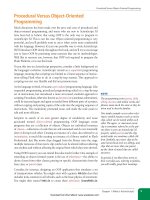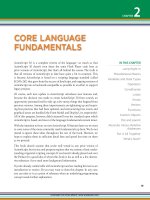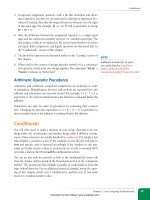Học Actionscript 3.0 - p 4 doc
Bạn đang xem bản rút gọn của tài liệu. Xem và tải ngay bản đầy đủ của tài liệu tại đây (4.94 MB, 10 trang )
Procedural Versus Object-Oriented Programming
Chapter 1: What Is ActionScript?
9
Procedural Versus Object-Oriented
Programming
Much discussion has been made over the pros and cons of procedural and
object-oriented programming, and many who are new to ActionScript 3.0
have been led to believe that using OOP is the only way to program in
ActionScript 3.0. This is not the case. Object-oriented programming is very
powerful, and you’ll probably want to use it when you’re more comfortable
with the language. However, it’s just one possible way to write ActionScript.
We’ll introduce OOP slowly throughout the book, and we’ll try to encourage
you to learn OOP by presenting some exercises that use its methodologies.
We’d like to reassure you, however, that OOP isn’t required to program the
Flash Platform, or to use this book.
To put this into an ActionScript perspective, consider a little background on
the language’s evolution. ActionScript started as a sequential programming
language, meaning that scripting was limited to a linear sequence of instruc-
tions telling Flash what to do in a step-by-step manner. This approach to
scripting was not very flexible and did not promote reuse.
As the language evolved, it became a procedural programming language. Like
sequential programming, procedural programming relied on a step-by-step
set of instructions, but introduced a more structured, modular approach to
scripting. Procedures, otherwise known as functions (or sometimes subroutines),
could be executed again and again as needed from different parts of a project,
without copying and pasting copies of the code into the ongoing sequence of
instructions. This modularity promoted reuse, and made the code easier to
edit and more efficient.
Scripters in search of an even greater degree of modularity and reuse
gravitated toward object-oriented programming. OOP languages create
programs that are a collection of objects. Objects are individual instances
of classes—collections of code that are self-contained and do not materially
alter or disrupt each other. Creating an instance of a class, also referred to as
instantiation, is much like creating an instance of a library symbol in Flash
Professional. Just like movie clips dragged from the library onto the stage,
multiple instances of that movie clip symbol can be altered without affecting
one another, and without affecting the original from which they were derived.
Using OOP, however, you can extend this idea much further. One example of
extending an object-oriented system is the use of inheritance—the ability to
derive classes from other classes, passing on specific characteristics from the
base class, or parent class.
Consider, for instance, designing an OOP application that simulates a set
of transportation vehicles. You might start with a generic
Vehicle class that
includes traits common to all vehicles, such as the basic physics of movement.
You might then extend
Vehicle to create three subclasses: GroundVehicle,
N O T E
The programming terms parent, child,
sibling, ancestor, and similar words and
phrases mean much the same as they do
when used to describe families.
One simple example occurs when refer-
ring to symbol instances such as movie
clips, which can be nested within each
other. The upper- or outermost movie
clip is sometimes referred to as the par-
ent (there is even an ActionScript 3.0
property called parent), and the clips
nested inside are sometimes called chil-
dren. Similarly, two movie clips at the
same hierarchical level are siblings, and
clips that are more than one parent
up the chain of nested clips are called
ancestors.
In general, if you liken these terms to
their everyday uses, referring to families,
you will readily grasp their meanings.
Download from Wow! eBook <www.wowebook.com>
Part I: Getting Started
10
Procedural Versus Object-Oriented Programming
WaterVehicle, and AirVehicle. These classes would alter or introduce
vehicle traits, making them specific to ground, water, and air travel, respec-
tively. However, these classes might not yet be complete enough to represent
an actual vehicle. Further derived classes might be
Car and Motorcycle
(descending from
GroundVehicle), Boat, and Submarine (descending from
WaterVehicle), and Plane and Helicopter (descending from AirVehicle).
Depending on the complexity of your system, you can carry on this process,
creating individual models with individual settings for fuel consumption,
friction, and so on.
Vehicle
Car SubmarineBoat
WaterVehicle
Motorcycle Plane Helicopter
GroundVehicle AirVehicle
Figure 1-1. An example of inheritance
As you can probably imagine, this approach to development adds additional
power, flexibility, and prospects for reuse. These benefits, among others,
sometimes position object-oriented programming as the best approach to a
problem. However, as we implied at the start of this section, there is a ten-
dency among some programmers to believe that OOP is the best solution to
all problems or, effectively, the only solution. This is flat-out untrue.
OOP is often best for large projects or for working with a team of program-
mers, but it can be overkill for small projects. Additionally, for the uninitiated,
it can significantly increase the learning curve and distract from key topical
concepts during your studies. In short, OOP is not always the best tool for the
job. Procedural programming still has its place, and Flash Professional allows
you to explore and employ both programming paradigms.
This book attempts to introduce material using both procedural and OOP
approaches where appropriate. Using object-oriented practices is a fine goal,
and one that we will encourage. However, we will try first to use simple pro-
cedural syntax to focus on the material central to each chapter, highlighting
syntax and explaining how and why each topic should be addressed in code.
Download from Wow! eBook <www.wowebook.com>
The Document Class
Chapter 1: What Is ActionScript?
11
In general terms, we will focus on procedural programming prior to Chapter 6.
Chapter 6 introduces OOP using a simplified version of the vehicle metaphor
and serves as a transition chapter between procedural and OOP practices.
Beginning with Chapter 7, chapters will introduce new concepts using simple
timeline syntax and, when appropriate, include an applied OOP example.
This is our preferred approach to presenting material for all possible users—
in both procedural and OOP formats. It is our hope that, regardless of your
skill and experience, you will hone in on the topics at hand, and then choose
to work using the timeline or classes based on your comfort level.
The Document Class
If you want to start thinking in OOP terms right away, you can easily take a
step in that direction. Remember that this is not necessary to get started and
that you should feel free to skip this section if you don’t want to be exposed
to classes yet. You won’t lose any momentum if you decide to skip ahead, as
all of this material will be discussed again in Chapter 6.
Flash Professional introduced a new feature that simplifies associating a main
class, or primary entry point for your application, with your FLA. In Flash
Professional, this class is called the document class, and it does all the work
of instantiating the class for you. This means you don’t need any code in the
timeline at all and can edit your code not only in Flash Professional, but also
in the external text editor or development environment of your choice.
Let’s start with a simulated chapter example that you might use in the time-
line. It does nothing more than use the
trace() statement to display text in
your authoring environment. In Flash Professional, this text will appear in
the Output panel, an authoring-only panel that accepts text output from your
file for diagnostic purposes.
In Flash Professional, use File
→New and create a new ActionScript 3.0 FLA
file. Select frame 1, and add the following to the Window
→Actions panel:
trace("Flash");
To accomplish this using a document class, you essentially need to create an
external file and enclose this instruction in the correct class syntax.
Users of Flash Professional CS3 and CS4 should use File
→New and create a
new ActionScript File (rather than a new FLA document). Users of Flash CS5
Professional will see this option as ActionScript 3.0 Class and most of this will
be taken care of for you (Figure 1-2).
N O T E
If you don’t plan to start using OOP
until we roll it out in later chapters, feel
free to skip this section as the material
is discussed again in Chapter 6. We will
provide minimal explanation here just
to get you going using document classes,
and will explain these concepts in great-
er detail in later chapters throughout
the book.
N O T E
As discussed previously, this book focus-
es strictly on ActionScript and assumes
a familiarity with the Flash Professional
application. If you are unfamiliar with
the Actions, Timeline, or Output panels,
please consult a reference on the Flash
Professional application, such as this
book’s companion volume, Learning
Flash CS4 Professional (O’Reilly). If
you are using another script editor,
please consult similar references for your
editor of choice.
Download from Wow! eBook <www.wowebook.com>
Part I: Getting Started
12
The Document Class
Figure 1-2. Creating a new class in Flash CS5 Professional
In the new file, type or edit the following:
1 package {
2
3 import flash.display.MovieClip;
4
5 public class Main extends MovieClip {
6
7 public function Main() {
8
9 }
10
11 }
12 }
The first line, along with the closing brace in line 12, defines the class’s pack-
age. This is a mandatory structure that tells the compiler where your class
resides. For simplicity, you will save your file in the same directory as the FLA
that will use this class, so no further syntax is required.
Next, you must import any additional classes that your class will reference.
The
import keyword doesn’t actually import anything; it just provides the
location of a class to the compiler so it can validate your code and include
the class when creating the SWF. Ordinarily, because this simple example
uses only the
trace() statement, you wouldn’t need any additional classes to
accomplish your goal. However, a document class is essentially a replacement
for your main timeline. Behind the scenes, the compiler will use an instance
of this class, instead of the main timeline, as the starting point for your
SWF. Therefore, your document class should extend, or be derived from, the
MovieClip class so that it inherits all the functionality of the main timeline.
So, as a result of extending the
MovieClip class in line 5, you must import the
MovieClip class, as seen in line 3.
Line 5, along with its closing brace on line 11, is the class definition. What you
decide to call your class (in this case, “Main”) is up to you, but when nam-
ing it you should follow a few basic rules and conventions. The name can’t
contain spaces, it can’t already exist in ActionScript, it should start with an
N O T E
When creating a document class, you
can also extend the
Sprite class,
which is essentially a movie clip with-
out a timeline. However, using the
MovieClip class for this purpose offers
more flexibility.
For example, although it’s not a good
idea to combine timeline code with a
document class (it’s best to think of the
document class as replacing the time-
line), it is possible only when the docu-
ment class extends
MovieClip.
For more information, see the “Sprite
versus MovieClip” post at the compan-
ion website.
Download from Wow! eBook <www.wowebook.com>
The Document Class
Chapter 1: What Is ActionScript?
13
alpha character (rather than a number or other character), and it is typically
capitalized.
You must add
public to line 5 when declaring the class, so that other parts of
your program can access it. We’ll cover this in detail in Chapter 6, but you can
control which parts of your class are accessible to other areas of your project.
For example, if you make something private, it will be accessible only from
within the class. Doing so can protect portions of your class from outside
manipulation and reduce conflicts with similar functionality that may exist
elsewhere in your project. The class, itself, however, must be public so that it
can be instantiated.
Line 7, along with its closing brace on line 9, define what is called the class
constructor. This is the main function that automatically runs when creating
an instance of this class. It, too, must be public and must have the same name
as the class. Other functions (if any) can, and must, have unique names, but
using the same name as the class identifies this function as the class construc-
tor, so it is executed upon instantiation.
All that remains to complete this document class is to add the lone instruc-
tion required to replicate the timeline example discussed previously. The
constructor must trace “Flash” to the Output panel, so add the following to
line 8:
7 public function Main() {
8 trace("Flash");
9 }
Now that you’re finished writing your class, name your file Main.as and save
it to a location you’ll remember. (In a moment, you’ll need to save an FLA to
this same location.) When creating a class, you must give the class, construc-
tor, and file the same name—the notable exception being that the file must
bear the .as extension.
Now, in Flash Professional, use File
→New and create a new ActionScript 3.0
FLA file. Because this simple example included no custom path instructions
in the package declaration in line 1 of your class, save your file in the same
directory as your class file. The name of the FLA is unimportant, so you may
as well call it main.fla.
Finally, open the Properties panel in the FLA and add the name of your class
to the document class field. (It’s labeled “Class” and appears in the Publish
section of the panel.) Use the name of the class, not the name of the file. In
this case, type
Main instead of Main.as, as seen in Figure 1-3.
Now compile your FLA file using the Control
→Test Movie menu com-
mand in Flash Professional, or Cmd-Return (Mac)/Ctrl-Return (Windows).
(For Flash Professional CS5 users, the command is now Control
→Test
Movie
→Test.) When your SWF runs, you should see “Flash” appear in the
output panel, and your test application will be complete. You can compare
Figure 1-3. Adding a document class to
your FLA
Download from Wow! eBook <www.wowebook.com>
Part I: Getting Started
14
Legacy Code Compatibility
your work to the files found in the document_class_example directory in the
accompanying source code.
Hereafter, you can try any of our timeline code in a document class of your
own. Initially, you probably won’t know which classes to import or how to
make any possible changes to variables or similar structures to conform to
the class syntax. However, all the sample code will come with an accompany-
ing class file for testing. You can use those files whenever you wish until you
get used to the document class format.
Legacy Code Compatibility
If you’ve worked with ActionScript 1.0 or 2.0 in the past—or even if you find
yourself updating legacy code created by someone else—it’s very impor-
tant to understand that you cannot mix ActionScript 1.0 or 2.0 code with
ActionScript 3.0 code in the same SWF. You are unlikely to do this if you’re
learning from scratch, but you may run into this limitation if you attempt to
update legacy projects by adding ActionScript 3.0 code.
If you ever have the need to run a discrete mixture of ActionScript 3.0 and
a prior version of the language, such as showing a legacy file within a new
demo interface shell, you can do so by loading a SWF. An ActionScript 3.0
file can load a SWF created in ActionScript 1.0 or 2.0, but it cannot directly
access the older SWF’s code. A SWF created in ActionScript 1.0 or 2.0, however,
cannot load an ActionScript 3.0 SWF.
In Chapter 13, we will discuss how to communicate between these two dis-
crete SWFs using a special process. For now, however, just remind yourself
again that you cannot combine ActionScript 3.0 with older versions of the
language in the same file.
Hello World
Now it’s time to write your first ActionScript 3.0 application. If you learned
about the document class earlier in this chapter, you’ve already done this.
That exercise, however, displayed text only within an authoring application
like Flash Professional—a technique used for testing and debugging, but
not for displaying text in your finished files. In this section, we’ll expand the
example to show you how to display text in the SWF files you send out into
the world. Using a text field makes a small leap, because we won’t discuss text
at length until Chapter 10, but our needs are meager for this example, and you
should have no problem at all. Our main goal is to give you a big-picture view
of the script-writing process and to give you some experience coding.
Download from Wow! eBook <www.wowebook.com>
Hello World
Chapter 1: What Is ActionScript?
15
Timeline Example
First you’ll create your Hello World application using a simple timeline script
to focus on the basic syntax. Then we’ll show you how to use a document
class to achieve the same result.
Create a new ActionScript 3.0 FLA file and type the following into a script in
frame 1 of the file.
Throughout this book, any time you want to create a timeline script, select a key-
frame in which you want the script to reside, open the Window
→Actions panel, and
write your code.
1 var txtFld:TextField = new TextField();
2 addChild(txtFld);
3
4 txtFld.text = "Hello World!";
When you’re finished, test your movie choosing Control→Test Movie in Flash
Professional. You should see the phrase, “Hello World!” in the upper-left cor-
ner of your published file.
N O T E
Because you use variables to store information for later retrieval, naming them in a
clear and meaningful way is important. Ideally, the name you choose should convey
the purpose of the variable whenever practical. You have a lot of freedom when
determining what to call your variables, but there are a few simple guidelines to
follow. We’ll discuss variables, including naming requirements and conventions, in
Chapter 2.
Line 1 of the script creates a new text field using the TextField class and
places a reference to that field into the variable
txtFld. Note the colon and
reference to the
TextField class immediately following the variable name.
This is called a data type and makes sure that only a compatible type of data
can be put into that variable—in this case, a
TextField instance. If you try to
put something else into this variable, an error is displayed, which can help
you spot problems with your code. Using data typing will save you lots and
lots of time, and we’ll talk about it in greater detail in Chapter 2.
Line 2 adds the text field to the display list so it can be seen at runtime.
Chapter 4 will explore this further, but put simply, the display list contains
everything you can see in your file. For example, a text field is a visual asset,
but a sound is not. For the user to see the text field, you must add it to the
display list, but this does not apply to the sound. Finally, line 4 puts the
phrase “Hello World!” into the text field. Default values for font, size, and
color are used to display the text in the field. You’ll learn how to manipulate
those characteristics in Chapter 10.
N O T E
When writing your own class files,
you’ll see that other classes referenced
therein (such as
MovieClip) must be
imported so the compiler knows where
to find them when publishing your
SWF. There are no import statements
in this script, however, because Flash
Professional does not require that you
import any class that is built into Flash
player when coding in the timeline.
In short, when referencing a class in the
timeline, if that class appears in a
flash
package—such as the
flash.text
package in which
TextField resides—it
doesn’t have to be imported. On the
other hand, classes in packages not
starting with
flash—such as class you
write or a class used with a component
like
fl.controls.Button—must still
be imported, even in the timeline.
For brevity, we will follow this guideline,
but importing classes does no harm. In
fact, as an interface improvement, Flash
Professional CS5 will often automatically
add import statements to your scripts
when you use a class in the timeline—
including those from the
flash package.
If you are using CS5, consider these auto-
matic imports when comparing line num-
bers between your code and the book.
Download from Wow! eBook <www.wowebook.com>
Part I: Getting Started
16
Hello World
Document Class Example
To recreate this example using a document class, place the same code inside
the constructor of the class—the only function included in this example. Take
the following steps to create the files required:
First, create a new ActionScript 3.0 file and type or edit the following code.
Save the file as HelloWorld.as and remember where you saved it.
1 package {
2
3 import flash.display.MovieClip;
4 import flash.text.TextField;
5
6 public class HelloWorld extends MovieClip {
7
8 public function HelloWorld() {
9 var txtFld:TextField = new TextField();
10 addChild(txtFld);
11
12 txtFld.text = "Hello World!";
13 }
14
15 }
16 }
Next, create a new ActionScript 3.0 FLA and save it in the same directory
in which you saved your class. The name of the FLA is not critical. In the
Properties panel in that FLA, add
HelloWorld to the document class field.
Finally, test your movie. You should see the small phrase, “Hello World!” on
the stage in the upper-left corner.
The class syntax here conforms to the syntax described in “The Document
Class” section of this chapter, with two small exceptions. (If you want to com-
plete this portion of the Hello World exercise, and haven’t already read that
section, please do so now.) The main difference is that the code in the class
constructor differs because its purpose differs. Like the timeline code used to
create the first Hello World example, this code uses a text field to display text,
instead of the Output panel. The second difference results from this change.
Because you are now using the
TextField class to create a new text field, you
must also import this class in line 4 so the compiler knows to include it.
Success
Congratulations! If you completed one or both of these Hello World exam-
ples, you just created an ActionScript-only application. You can compare your
work to the hello world_timeline.fla file and/or the files in the hello_world_
document_class directory, both found in the accompanying source code at
.
Download from Wow! eBook <www.wowebook.com>
What’s Next?
Chapter 1: What Is ActionScript?
17
What’s Next?
Now that you know a little more about ActionScript 3.0 and the Flash
Platform, it’s time for a look at some of the fundamentals of the language.
By reviewing version-independent concepts at the outset, we can focus on
new syntax in subsequent chapters. If you have a lot of experience with
ActionScript 1.0 or 2.0, you may wish to skim Chapter 2.
In the next chapter, we’ll discuss:
• Basic concepts to bring you up to speed quickly, including using the
trace() statement as a diagnostic tool to see immediate feedback from
your scripts
• Using variables to store data (including arrays and custom objects that
allow you to easily manage more than one value) and data typing to
improve error reporting
• Structures such as conditionals for decision making and loops for simpli-
fying repetitive tasks
• Functions that can isolate code into convenient blocks that will be execut-
ed only when instructed
• Ways to address Flash objects with ActionScript, including using absolute
and relative paths, and the identifier
this
Download from Wow! eBook <www.wowebook.com>
Download from Wow! eBook <www.wowebook.com>









